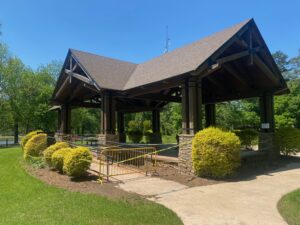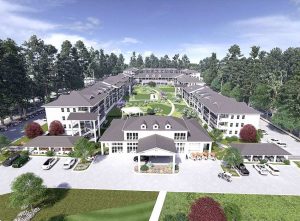The years-long battle over the fate of a potential retail venue along Ga. Highway 54 West adjacent to the Planterra Ridge subdivision in Peachtree City came to a partial end Sept. 22 when Peachtree City Planning Commission members voted unanimously to approve a concept plat for the 69,000 square-foot McIntosh Village retail subdivision that will lead to the 14.3-acre tract being subdivided into a number of separate lots to be sold individually for development.
The plan calls for the site to be served by a right-in, right-out access point off Hwy. 54 West, but Trinity is hopeful that a traffic light will be approved for the intersection.
Though commissioners repeatedly clear that they were reluctant to approve the proposal by Trinity Development, that reluctance could not override the simple and brief statements of Trinity’s attorney Doug Dillard which left no wiggle room on the issue.
“We have totally complied with all your rules and regulations and we feel that as long as we comply you must approve it,” Dillard said of Trinity’s compliance with all provisions of the city’s ordinance pertaining to the approval for a concept plat. “This is your process, not our process.”
The approved plan calls for the property to be subdivided and sold as individual lots with those owners returning to the planning commission for development approval. Several neighbors in the area have expressed concern that will lead to “piecemeal” development of the property, which won’t be as aesthetically pleasing as if the entire property were developed at the same time with a unified plan.
The upshot is that as each portion of the area is developed, the individual concept plans must be brought back to the commission for approval. Each plan will be reviewed to insure it meets all applicable city ordinances.
Trinity initially had proposed to develop the site and lower the grade of the rear portion of the site which abuts the Cardiff Park subdivision. But since the Peachtree City Council decided not to sell the streets of Line Creek Drive and Line Creek Court, that leaves Trinity unable to lower the grade of the rear section of the property.
Without the streets in Trinity’s possession, the developable area of the site is greatly reduced because Trinity has to comply with the city’s road setback guidelines.
The submitted graphic for the concept plat showed nine buildings for a total of 69,000 sq. ft. located around the property with the largest being a 32,000 sq. ft. structure, the maximum allowed by ordinance. But both Dillard and Trinity representative Jim Lowe on several occasions explained that the graphic showing the buildings and their placement on the property was representational in nature. The actual number of buildings and their square footage would depend on market preferences when the lots are sold, they said.
Consistent with the remarks of Lowe and Dillard, city Planning and Zoning Administrator David Rast in a Sept. 16 memo said, “Because there are no confirmed tenants or businesses for the retail subdivision the applicant has developed schematic site plans for each parcel to show how the property might be subdivided and ultimately developed. The individual site plans appear to comply with applicable building and parking setbacks. It is understood that as each tract is sold and ultimately developed, they would be presented to staff and the Planning Commission for review in a workshop format prior to approval of the conceptual site plan. It is also understood that development on each tract would comply with the requirements identified with the General Commercial zoning ordinance, the SR 54 West Design Guidelines and the city’s Design Guidelines Ordinance.”
The approved plan includes a required 75-foot transitional buffer yard area adjacent to the Cardiff Park subdivision. The buffer area will be established and landscaped as each tract adjacent to Cardiff Park is developed.
A number of Cardiff park residents at the meeting were joined by everyone on the commission in expressing their concerns about the proposal. And while commissioners agreed with neighbors who have long-questioned the appropriateness of having various types of retail venues located so close to a residential area, it was Commissioner Linda Wojcik who perhaps summed up the subsequent approval by the board as well as anyone.
“This is all the developer can do. This is all the board can do. We’ve given them no other option,” Wojcik said in reference to Trinity’s previous attempts to win approval from the commission for other concepts.
The 14.3-acre site is zoned for general commercial use and has seen a number of unsuccessful retail proposals spanning the past several years.
The parcel is currently owned by BB&T Bank.











Leave a Comment
You must be logged in to post a comment.